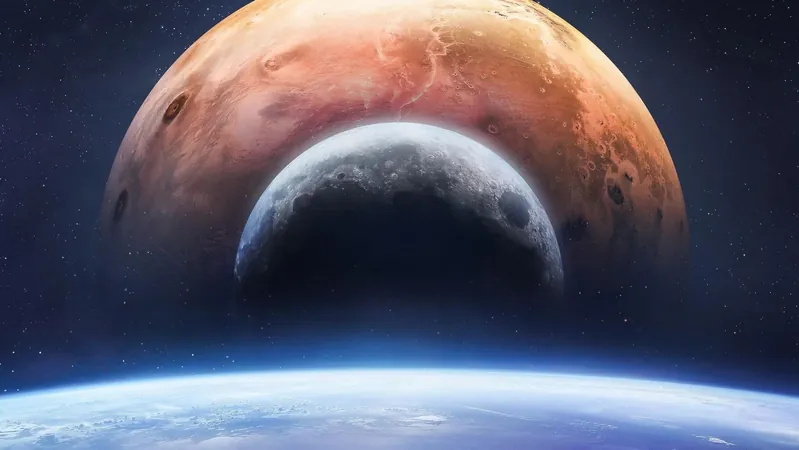
Witness the Spectacular Wolf Moon and Mars: Your Ultimate Guide to January 2025's Celestial Show!
2025-01-09
Author: Olivia
Get ready for a cosmic spectacle as January 2025 brings us the renowned Wolf Moon, illuminating winter skies in a brilliant display! This full moon will rise on Monday, January 13, but its enchanting view will truly captivate stargazers on Tuesday, January 14, when it lights up the evening sky at dusk. As it ascends from the eastern horizon, expect to be dazzled by its gentle palette of oranges, yellows, and pinks.
The Wolf Moon, known by various names such as the Old Moon, Ice Moon, and Snow Moon, will be nestled in the constellation of Gemini. Here’s your comprehensive guide on when, where, and how to catch a glimpse of this breathtaking phenomenon:
When to See the Wolf Moon?
Mark your calendars! The Wolf Moon reaches its full phase at 5:28 p.m. EST on January 13, but the optimal viewing opportunity will be just after sunset on the evening of January 14, 2025.
Best Viewing Times for the Full Wolf Moon
To see this lunar marvel at its best, find a vantage point facing east, ideally right after the sun slips below the horizon. During this magical moment, the moon will appear brighter than normal, adorned in a beautifully muted orange hue. The specific time of moonrise will vary depending on your location, so check local times.
For example, in major cities across the globe: - New York: Sunset at 4:52 p.m. EST; Moonrise at 5:40 p.m. EST. - Los Angeles: Sunset at 5:05 p.m. PST; Moonrise at 6:04 p.m. PST. - London: Sunset at 4:19 p.m. GMT; Moonrise at 4:44 p.m. GMT.
Tips for Observing the Full Wolf Moon
For the best experience, choose a high location that gives you an unobstructed view to the east, or visit an east-facing coast. On a clear night, your unaided eyes will offer a great view, but binoculars can enhance the experience, giving you a closer look at this lunar beauty.
A Celestial Double Feature: Occultation of Mars
But that's not all! Just before the Wolf Moon's grand display, get ready for a rare sight—the near-full moon will occult the Red Planet, Mars. This event will be observable across North America, starting from 8:44 p.m. EST on January 13 until 12:52 a.m. EST on January 14. Depending on your specific location, this occultation will create a thrilling visual experience, where Mars will disappear, only to reappear shortly afterward. Be sure to check online resources, like in-the-sky.org, for detailed maps and timings specific to your area.
Why the Wolf Moon Shines Brightest in January
This January's full moon stands out as the highest full moon of the year in the Northern Hemisphere. Due to the moon's opposition to the sun, as winter solstice approaches, the full moon is inherently positioned at its peak. Consequently, this Wolf Moon will grace the night sky longer than any other full moon throughout 2025.
What’s Next? Mark Your Calendars for the Next Full Moon!
Following the Wolf Moon, stargazers can look forward to the full Snow Moon on February 12, 2025, which will reach its peak at 5:41 p.m. EST, serving as the second full moon of winter.
Get ready for a night filled with wonder as the Wolf Moon and Mars take center stage! Clear skies and wide eyes are what we wish for you on this extraordinary night! Don’t miss out; gather your friends, grab a cozy blanket, and step outside to experience the magic of the universe!









 Brasil (PT)
Brasil (PT)
 Canada (EN)
Canada (EN)
 Chile (ES)
Chile (ES)
 Česko (CS)
Česko (CS)
 대한민국 (KO)
대한민국 (KO)
 España (ES)
España (ES)
 France (FR)
France (FR)
 Hong Kong (EN)
Hong Kong (EN)
 Italia (IT)
Italia (IT)
 日本 (JA)
日本 (JA)
 Magyarország (HU)
Magyarország (HU)
 Norge (NO)
Norge (NO)
 Polska (PL)
Polska (PL)
 Schweiz (DE)
Schweiz (DE)
 Singapore (EN)
Singapore (EN)
 Sverige (SV)
Sverige (SV)
 Suomi (FI)
Suomi (FI)
 Türkiye (TR)
Türkiye (TR)